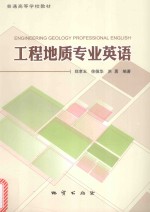

工程地质专业英语PDF电子书下载
- 电子书积分:8 积分如何计算积分?
- 作 者:郑孝玉,徐佩华,洪勇编著
- 出 版 社:北京:地质出版社
- 出版年份:2015
- ISBN:9787116093973
- 页数:148 页
Introduction 1
Unit 1 Engineering Properties of Rocks(Part 1) 5
Unit 2 Engineering Properties of Rocks(Part 2) 11
2.1 The Nature of Soils 11
2.2 Particle Size and Analysis 14
2.3 Plasticitv of Fine-grained Soils 16
2.4 Soil Compaction 17
Unit 3 Rock Mass Classification 20
3.1 Engineering Rock Mass Classification 20
3.2 Terzaghi's Rock Mass Classification 21
3.3 Classifications Involving Stand-up Time 22
3.4 Rock Quality Designation Index(RQD) 22
Unit 4 Pore Pressure and Effective Stress 26
4.1 Stress in the Ground 26
4.2 Groundwater and Pore Pressure 26
4.3 Effective Stress 28
4.4 Importance of Effective Stress 29
4.5 Volume Change and Drainage 30
4.6 Drained Loading,Undrained Loading&Consolidation 31
4.7 Rates of Loading and Drainage 31
Unit 5 In Situ Testing 35
5.1 Penetrometers 35
5.2 Shear Vane Test 37
5.3 Plate Load and Jacking Tests 37
5.4 Pressure Tests 39
5.5 In Situ Shear Test 41
Unit 6 Consolidation Theory 44
6.1 The Oedometer Test 44
6.2 Compressibility Characteristics 45
6.3 Preconsolidation Pressure 46
6.4 1-D Consolidation Settlement 47
6.5 Degree of Consolidation 48
6.6 Terzaghi's Theory of One-Dimensional Consolidation 48
6.7 Second Compression 49
Unit 7 Bearing Capacity 52
7.1 Stress Distribution in Soil 52
7.2 Foundation Failure 53
7.3 Bearing Capacity Factors 53
7.4 Contact Pressure 54
7.5 Allowable Contact Pressure For Rock Masses 54
Unit 8 Shear Strength(Part 1) 57
8.1 The Mohr—Coulomb Failure Criterion 57
8.2 Shear Strength Tests 59
Unit 9 Shear Strength(Part 2) 67
9.1 Shear Strength of Sands 67
9.2 Shear Strength of Saturated Clays 69
9.3 The Critical State Concept 75
9.4 Residual Strength 75
Unit 10 Foundations for Buildings 79
10.1 Types of Foundation Structure 79
10.2 Bearing Capacity 80
10.3 Settlement 82
10.4 Methods of Ground Treatment 83
Unit 11 Embankment Dams:Introduction,Terminology,and Classification 87
Unit 12 Methods of Slope Control and Stabilization 94
12.1 The Stability of Slopes 94
12.2 Reinforcement of Slopes 97
12.3 Drainage of Slopes 101
Unit 13 Debris Flow:Introduction,Observation and Measurement 105
13.1 Introduction 105
13.2 Observations and Measurements for Debris Flow 107
Unit 14 Natural Subsidence and Influence of Geological Processes 112
14.1 Introduction 112
14.2 The Meaning of Subsidence 113
14.3 Geological Cycle in Relation to Natural Subsidence 113
14.4 Sedimentary Basin Subsidence 114
14.5 Dolines,Swallow-holes,Sink-holes and Crown-holes 114
14.6 Subsidence Arising From Development of Subterranean Voids 115
14.7 Conclusion 116
Unit 15 Underground Caverns 120
15.1 Location of Underground Cavern 120
15.2 Stability of Underground Caverns 120
15.3 Influence of Joints 121
15.4 Exeavation of Underground Caverns 122
Unit 16 Environmental Geology 125
16.1 Introductory Remarks 125
16.2 Geology and Regional Planning 125
16.3 Urban Planning 126
16.4 Waste Disposal 127
16.5 Geological Hazards 129
16.6 Environmental Impact Statements 131
16.7 Earthquake Hazards and Nuclear Power Stations 133
Unit 17 Tasks of Geological Investigation 136
17.1 Man as a Geological Agent 136
17.2 Regional Planning 137
17.3 Geological Analysis 139
17.4 Hydrogeological Analysis 140
17.5 Geological Investigation in Planning and Building of Settlements 143
References 148
- 《市政工程基础》杨岚编著 2009
- 《工程静力学》王科盛主编 2019
- 《中央财政支持提升专业服务产业发展能力项目水利工程专业课程建设成果 设施农业工程技术》赵英编 2018
- 《化学反应工程》许志美主编 2019
- 《基于地质雷达信号波的土壤重金属污染探测方法研究》赵贵章 2019
- 《绿色过程工程与清洁生产技术 张懿院士论文集精选 上》《绿色过程工程与清洁生产技术》编写组编 2019
- 《软件工程》齐治昌,谭庆平,宁洪编著 2019
- 《化学工程与工艺专业实验指导》郭跃萍主编 2019
- 《天水师范学院60周年校庆文库 新工科视域下的工程基础与应用研究》《天水师范学院60周年校庆文库》编委会编 2019
- 《高等工程教育改革探析》李瀛心,吴价宝著 1997
- 《市政工程基础》杨岚编著 2009
- 《家畜百宝 猪、牛、羊、鸡的综合利用》山西省商业厅组织技术处编著 1959
- 《《道德经》200句》崇贤书院编著 2018
- 《高级英语阅读与听说教程》刘秀梅编著 2019
- 《计算机网络与通信基础》谢雨飞,田启川编著 2019
- 《看图自学吉他弹唱教程》陈飞编著 2019
- 《法语词汇认知联想记忆法》刘莲编著 2020
- 《培智学校义务教育实验教科书教师教学用书 生活适应 二年级 上》人民教育出版社,课程教材研究所,特殊教育课程教材研究中心编著 2019
- 《国家社科基金项目申报规范 技巧与案例 第3版 2020》文传浩,夏宇编著 2019
- 《流体力学》张扬军,彭杰,诸葛伟林编著 2019
- 《指向核心素养 北京十一学校名师教学设计 英语 七年级 上 配人教版》周志英总主编 2019
- 《北京生态环境保护》《北京环境保护丛书》编委会编著 2018
- 《基于地质雷达信号波的土壤重金属污染探测方法研究》赵贵章 2019
- 《指向核心素养 北京十一学校名师教学设计 英语 九年级 上 配人教版》周志英总主编 2019
- 《高等院校旅游专业系列教材 旅游企业岗位培训系列教材 新编北京导游英语》杨昆,鄢莉,谭明华 2019
- 《中国十大出版家》王震,贺越明著 1991
- 《近代民营出版机构的英语函授教育 以“商务、中华、开明”函授学校为个案 1915年-1946年版》丁伟 2017
- 《指向核心素养 北京十一学校名师教学设计 数学 九年级 上 配人教版》周志英总主编 2019
- 《西单大杂院-北京老舍文学院首届中青年作家高研班学员小说作品集》北京老舍文学院编 2019
- 《指向核心素养 北京十一学校名师教学设计 数学 七年级 上 配人教版》周志英总主编 2019
